Vascular Trauma Treatment in Vadodara by Dr. Sumit Kapadia
Vascular trauma refers to any injury that damages the arteries, veins, or capillaries — often resulting from accidents, blunt trauma, penetrating wounds, or fractures. These injuries can be life-threatening if not treated promptly. At Department of Vascular & Endovascular Surgery at Aadicura Superspeciality Hospital, Dr. Sumit Kapadia offers advanced, timely, and limb-saving care for vascular trauma.
Dr. Sumit Kapadia, a leading vascular surgeon in Gujarat, is renowned for his expertise in trauma-related vascular repairs and complex vascular reconstructions, making him a trusted name across the region.
Symptoms of Vascular Trauma
Vascular trauma can present immediately or develop progressively. Key symptoms include:
- Sudden bleeding or oozing from a wound
- Absent or weak pulse in a limb
- Swelling or bruising near a bone fracture or wound
- Pale, cold, or blue-colored skin
- Tingling or numbness in the affected area
- Pulsating hematoma (lump)
- Severe pain in the limb
- Loss of limb function or movement
If you notice any of these signs, seek emergency care immediately.
How Is Vascular Trauma Diagnosed?
Prompt diagnosis is crucial to prevent long-term damage. Common diagnostic tests include:
- Physical examination (pulse check, capillary refill)
- Doppler ultrasound – to detect blood flow blockage
- Angiography or CT Angio is vital for identifying complex conditions like femoral AV fistula, pseudoaneurysms, or vessel transections hidden under swelling or fractures.
- Duplex scan – combines traditional ultrasound and Doppler flow
- Arteriography – X-ray imaging after contrast dye injection
These tests help identify the location, extent, and severity of vascular injury.
Treatment Options for Vascular Trauma
Treatment is determined based on the injury’s type, location, and severity. Options include:
- Primary Repair – stitching or suturing the vessel
- Ligation – tying off a severely damaged vessel
- Bypass Grafting – creating a detour using a vein or synthetic graft
- Endovascular Repair – using stents or catheters (minimally invasive)
- Thrombectomy – removal of clots to restore blood flow
- Fasciotomy – relieving compartment pressure in the limb
- Popliteal artery injury repair – done via open surgery or endovascular approach to restore blood flow in the knee region
- Brachial artery repair in supracondylar humerus fractures – especially in children, done alongside orthopedic fixation
- Femoral AV fistula repair – surgically correcting abnormal connection between artery and vein due to trauma
- Angioembolisation – a non-surgical method to block bleeding vessels, especially after fracture fixation or pelvic injuries
- Pseudoaneurysm repair (e.g., popliteal pseudoaneurysm) – treated with endovascular coil embolisation or surgical ligation
Dr. Sumit Kapadia’s center is equipped with state-of-the-art endovascular tools for minimally invasive repairs wherever possible.
Gallery

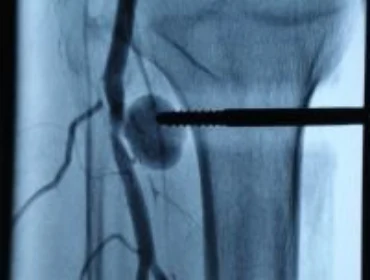
Popliteal pseudoaneurysm

Angioembolisation for bleeding after fracture fixation
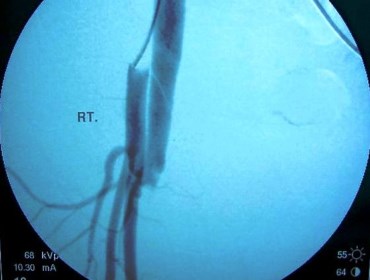
Angiography shows Femoral AV Fistula
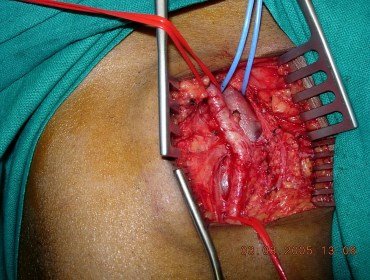
Femoral AV Fistula Repair
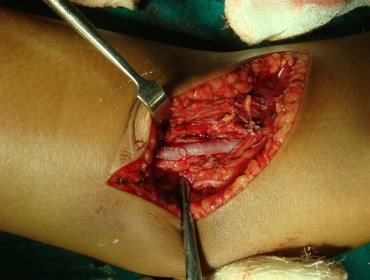
Brachial repair in supracondylar humerus fracture
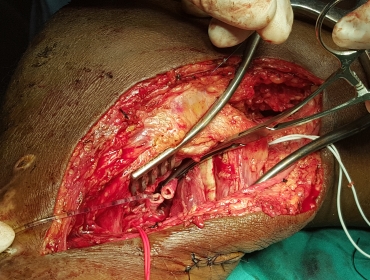
Popliteal artery injury repair
Cost of Vascular Trauma Treatment in India
The cost of vascular trauma treatment in India depends on the complexity of the case, whether surgery is open or endovascular, hospital stay, and associated procedures. In Vadodara and Gujarat, vascular trauma surgeries can range between ₹80,000 to ₹2,50,000.
We provide transparent estimates and offer guidance for insurance and mediclaim support.
What the Treatment Involves
Once diagnosed, the treatment begins with stabilisation of the patient, controlling bleeding, and assessing limb viability. Depending on the injury, Dr. Kapadia may opt for:
- Emergency open repair for major vessel damage
- Minimally invasive endovascular techniques for internal injuries
- Combined orthopedic and vascular management for fractures with vessel injury
Each case is tailored for limb salvage and function restoration. The aim is to restore blood flow, prevent tissue death, and avoid amputation.
For example, in supracondylar humerus fractures, children may suffer from brachial artery injury, requiring vascular repair at the same time as fracture fixation.
Another critical case is popliteal artery injury following knee dislocations — urgent repair is essential to avoid amputation.
Benefits & Effectiveness
- Rapid blood circulation restoration
- Reduced risk of limb loss
- High success rates with early intervention
- Minimal scarring and faster recovery (in endovascular approach)
- Preservation of limb function and mobility
With Dr. Sumit Kapadia’s 18+ years of surgical experience, patients receive world-class vascular care right here in Vadodara.
Ideal Candidates for Vascular Trauma Surgery
You should consider vascular trauma treatment if:
- You’ve had a road traffic accident, fall, or industrial injury with heavy bleeding
- You’re experiencing coldness, numbness, or colour change in the limb
- You have signs of a blood clot after trauma
- You’ve had a fracture or dislocation with reduced limb pulse
- You’ve undergone a failed orthopedic surgery with poor limb blood flow
Early detection and treatment ensure better outcomes and fewer complications.
During the Procedure
Depending on the treatment method:
- Open surgery may involve general anaesthesia,an incision over the vessel, and repair or bypass
- Endovascular repair involves small groin or arm puncture, stent placement using fluoroscopy
- The procedure duration ranges from 1 to 4 hours, based on injury type
Our operating team ensures sterile, safe, and patient-focused care throughout.
Recovery and Aftercare
- Hospital stay: 3 to 7 days, depending on surgery type
- Resume basic movements: within 48 hours (with physiotherapy support)
- Full recovery: 2 to 6 weeks (case-dependent)
- Medications: Blood thinners, pain relief, infection prevention
- Lifestyle modifications: Smoking cessation, limb elevation, compression therapy (if advised)
Regular follow-ups with Doppler scans or CTA may be required.
Successful Treatments

1. Popliteal injury
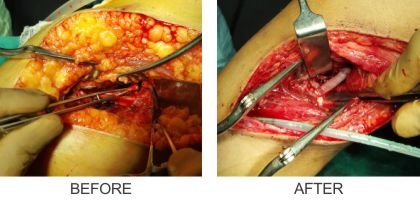
2. Gunshot induced Iliac Arterio-Venous Fistula
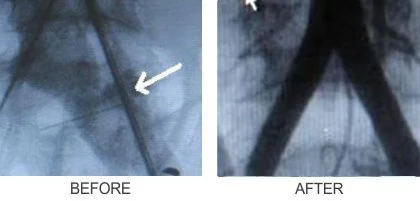
Frequently Asked Questions (FAQs)
Yes, in selected cases, minimally invasive methods like stenting or clot removal can avoid open surgery.
Delayed treatment can lead to limb loss, nerve damage, infection, or even death due to internal bleeding.
Yes. Most vascular surgeries are covered under health insurance or accident policies.
Within 6 hours is ideal to preserve limb function and prevent complications.
Absolutely. Dr. Sumit Kapadia offers international-standard vascular care with high success rates and modern techniques
Vascular trauma treatment involves medical or surgical management of injured blood vessels caused by accidents, fractures, or penetrating wounds. The goal is to restore blood flow, prevent tissue death, and preserve limb function.
Treatment depends on the severity. Minor injuries may need medication and monitoring, while major vascular damage may require vascular surgery, bypass grafting, or endovascular repair using stents or catheters.
In most cases, vascular trauma does not heal on its own. Delayed or missed treatment can lead to complications like limb loss, gangrene, or internal bleeding. Immediate medical evaluation is essential.
The best treatment depends on the condition. It may include lifestyle changes, medications, angioplasty, stenting, or vascular surgery. For trauma-related vascular issues, surgical repair is often necessary.
Vascular damage can be repaired by suturing the vessel (primary repair), using a graft or stent to bypass the damaged area, or by removing clots. The choice of method depends on injury location and severity.
Key symptoms include bleeding, limb swelling, cold or pale skin, loss of pulse, severe pain, and limited movement. Bruising or a pulsating lump may also be signs of vascular injury.
Mild vascular discomfort from chronic issues may be eased with leg elevation, compression stockings, hydration, exercise, and a low-salt diet. However, trauma-related vascular pain should never be treated at home — it needs medical attention.
Yes, moderate walking improves circulation, strengthens blood vessels, and reduces clot risk. But after vascular trauma or surgery, walking should be resumed only under medical guidance.
Costs vary by hospital, location, and complexity. On average, vascular trauma surgeries in Vadodara range between ₹80,000 to ₹2,50,000, including diagnostics, procedure, and post-operative care.
Yes. With early diagnosis, vascular diseases are manageable and sometimes reversible. Trauma-related injuries, if treated quickly, often have excellent recovery outcomes.
The classic “hard signs” include:
- Active or pulsatile bleeding
- Absent distal pulse
- Expanding hematoma
- Bruit or thrill over the injury site
- Signs of limb ischemia (cold, pale, numb limb)
To support vascular health naturally, adopt a heart-healthy diet, quit smoking, exercise regularly, manage stress, and stay hydrated. But trauma-related vascular injuries require surgical intervention.
Treatment may include pain relievers, anti-inflammatory medications, nerve blocks, or surgical correction of underlying vascular problems. A proper diagnosis is essential to address the root cause.
Cardiologists may manage some vascular conditions, but for vascular trauma or peripheral vascular diseases, a vascular surgeon like Dr. Sumit Kapadia is the ideal specialist.
Recovery varies by procedure. Minimally invasive vascular repairs may take 1–2 weeks, while open surgeries may need 4–6 weeks of rest, physiotherapy, and follow-ups
If you or a loved one is facing a vascular injury or post-traumatic swelling or pain, don’t wait. Early diagnosis can save a limb.



